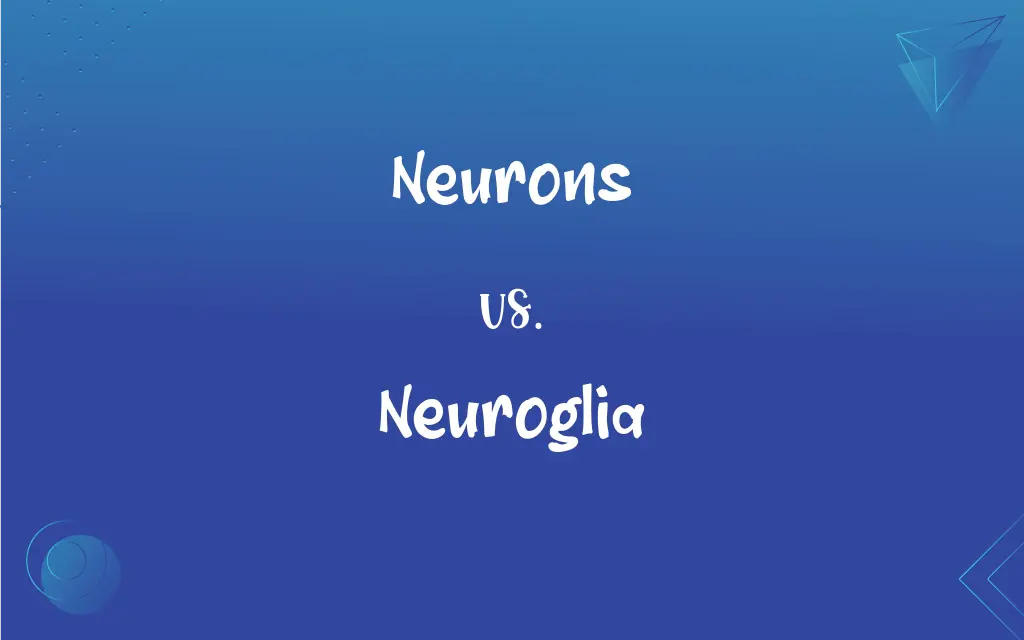Neurons vs. Neuroglia: What's the Difference?
Edited by Janet White || By Harlon Moss || Updated on October 13, 2023
Neurons refers to the principal cells in the nervous system transmitting signals. Neuroglia refers to cells that support, protect, and assist neurons.

Key Differences
Neurons are essential for transmitting electrochemical signals across the nervous system. Neuroglia, in contrast, play a vital role in supporting and protecting neurons, ensuring they function optimally.
Neurons boast a unique structure, comprising a cell body, axon, and dendrites, to facilitate signal transmission. Neuroglia differ in structure and are not involved in signal transmission but are fundamental in maintaining a healthy neuronal environment.
Neurons use action potentials to communicate information across vast networks within the nervous system. Neuroglia, however, do not convey information via electrical impulses but work in various other ways, such as clearing away debris and providing nutrients to neurons.
Neurons can be excitatory or inhibitory, influencing the activity of other neurons in the network. Neuroglia, while inactive in direct communication, modulate neuronal activity indirectly by regulating the extracellular fluid composition.
Neurons are sensitive and can be easily damaged, requiring consistent support and nourishment. Neuroglia contribute to maintaining a stable environment, protecting neurons, and aiding in recovery post-injury.
ADVERTISEMENT
Comparison Chart
Primary Function
Transmitting electrical and chemical signals
Supporting and protecting neurons
Communication
Via action potentials
Do not transmit action potentials
Structure
Contains axons and dendrites
Varies, lacks axons and dendrites
Role in Information Processing
Crucial
Negligible
Regeneration
Limited post-injury regeneration capacity
Capable of dividing and regenerating
ADVERTISEMENT
Neurons and Neuroglia Definitions
Neurons
Specialized cells transmitting nerve impulses.
The neurons communicate through electrochemical signals.
Neuroglia
Non-neuronal cells aiding in synaptic functioning and stability.
By regulating synaptic spaces, neuroglia indirectly influence neural communication.
Neurons
The primary units of the nervous system involved in information processing.
Neurons in the brain are integral to memory and learning.
Neuroglia
Cells contributing to maintaining the homeostatic balance in the brain.
Neuroglia play a crucial role in managing the extracellular environment of neurons.
Neurons
Entities that can connect and establish intricate networks for data transmission.
Neural networks consist of interconnected neurons, facilitating complex thinking.
Neuroglia
Entities that are imperative for repairing and maintaining neuronal health.
After a neural injury, neuroglia work diligently to manage damage and facilitate repair.
Neurons
Vital cells influencing both voluntary and involuntary actions.
Neurons in the spinal cord regulate reflex actions without brain involvement.
Neuroglia
Diverse cells providing nutritional support and insulating neurons.
Neuroglia, like oligodendrocytes, create myelin sheaths that insulate neurons.
Neurons
Cells capable of generating and transmitting electrical impulses.
Neurons transmit information at astonishing speeds across synaptic connections.
Neuroglia
Support cells within the nervous system aiding neuron functionality.
Neuroglia ensure the optimal functionality of neurons by providing structural support.
Neurons
Any of the impulse-conducting cells that constitute the brain, spinal column, and nerves in vertebrates, consisting of a nucleated cell body with one or more dendrites and a single axon.
Neuroglia
The supportive tissue of the nervous system, including the network of branched cells in the central nervous system (astrocytes, microglia, and oligodendrocytes) and the supporting cells of the peripheral nervous system (Schwann cells and satellite cells). Also called glia.
Neurons
A similar impulse-conducting cell in invertebrates.In both senses also callednerve cell.
Neuroglia
(cytology) glial cell
Neurons
Plural of neuron
Neuroglia
The delicate connective tissue framework which supports the nervous matter and blood vessels of the brain and spinal cord; called also Kölliker's reticulum. It is composed of cells which are not neurons. Once thought to serve merely a supporting funciton, they are now believed to have important metablolic functions. Among them are the astrocytes, ependymal cells, oligodendroglia cells, and microglia cells.
Neuroglia
Sustentacular tissue that surrounds and supports neurons in the central nervous system; glial and neural cells together compose the tissue of the central nervous system
FAQs
Are neuroglia involved in synaptic transmission like neurons?
Neuroglia are not directly involved in synaptic transmission but play a supportive role in maintaining the synaptic environment.
What is the primary function of neurons?
Neurons are crucial for transmitting electrochemical signals within the nervous system.
Do neuroglia transmit electrical impulses like neurons?
No, neuroglia do not transmit electrical impulses; they support and protect neurons.
How do neurons communicate with each other?
Neurons communicate through synaptic transmissions, involving chemical neurotransmitters and electrical impulses.
What is the role of neurons in memory formation?
Neurons, through interconnected networks and synaptic plasticity, play a crucial role in encoding, storing, and retrieving memories.
Can neurons regenerate after being damaged?
Neurons have limited regenerative capabilities, particularly in the central nervous system.
How do neurons communicate across the synaptic gap?
Neurons communicate across synapses by releasing neurotransmitters, which cross the synaptic gap and bind to receptors on adjacent neurons.
Can neuroglia generate action potentials like neurons?
No, neuroglia do not generate action potentials; instead, they perform supportive and regulatory functions.
How many types of neurons are there?
There are several types of neurons, primarily categorized as sensory, motor, and interneurons.
What is the role of neuroglia in neurodegenerative diseases?
Neuroglia, especially microglia, are involved in the inflammatory response and can influence the progression of neurodegenerative diseases.
How do neuroglia contribute to the recovery of neurons post-injury?
Neuroglia engage in repair processes, such as walling off damaged areas, clearing debris, and potentially forming scar tissue, assisting in the recovery post-neural injury.
What is synaptic plasticity, and how do neurons contribute to it?
Synaptic plasticity refers to the ability of synapses to strengthen or weaken over time, with neurons contributing by altering their transmission efficiency and connectivity.
How do neuroglia influence communication between neurons?
While not directly involved in synaptic transmission, neuroglia maintain the health and stability of the synaptic environment, indirectly influencing neuron communication.
How do neuroglia protect neurons from pathogens and damage?
Neuroglia, particularly microglia, engage in protective functions, such as engulfing pathogens and debris, and maintaining the defensive blood-brain barrier.
Are neuroglia able to divide and multiply?
Yes, unlike neurons, neuroglia can divide and multiply, particularly in response to injury or disease.
What constitutes the structure of a neuron?
A neuron typically comprises a cell body, dendrites for receiving signals, and an axon for sending signals.
How do neuroglia contribute to maintaining the brain's homeostasis?
Neuroglia help regulate the extracellular fluid and ions, remove debris, and provide nutrients to neurons.
How do neurons encode information?
Neurons encode information through the generation, propagation, and modulation of electrical impulses or action potentials.
Can neuroglia transmit information like neurons?
No, neuroglia do not transmit information like neurons but play a critical role in supporting and modulating neural communication.
Are neurons and neuroglia found in both the brain and spinal cord?
Yes, neurons and neuroglia are found throughout the nervous system, including both the brain and spinal cord.
About Author
Written by
Harlon MossHarlon is a seasoned quality moderator and accomplished content writer for Difference Wiki. An alumnus of the prestigious University of California, he earned his degree in Computer Science. Leveraging his academic background, Harlon brings a meticulous and informed perspective to his work, ensuring content accuracy and excellence.
Edited by
Janet WhiteJanet White has been an esteemed writer and blogger for Difference Wiki. Holding a Master's degree in Science and Medical Journalism from the prestigious Boston University, she has consistently demonstrated her expertise and passion for her field. When she's not immersed in her work, Janet relishes her time exercising, delving into a good book, and cherishing moments with friends and family.































































